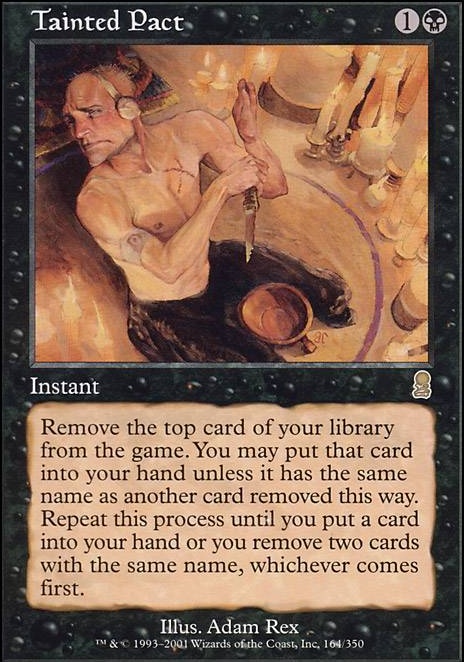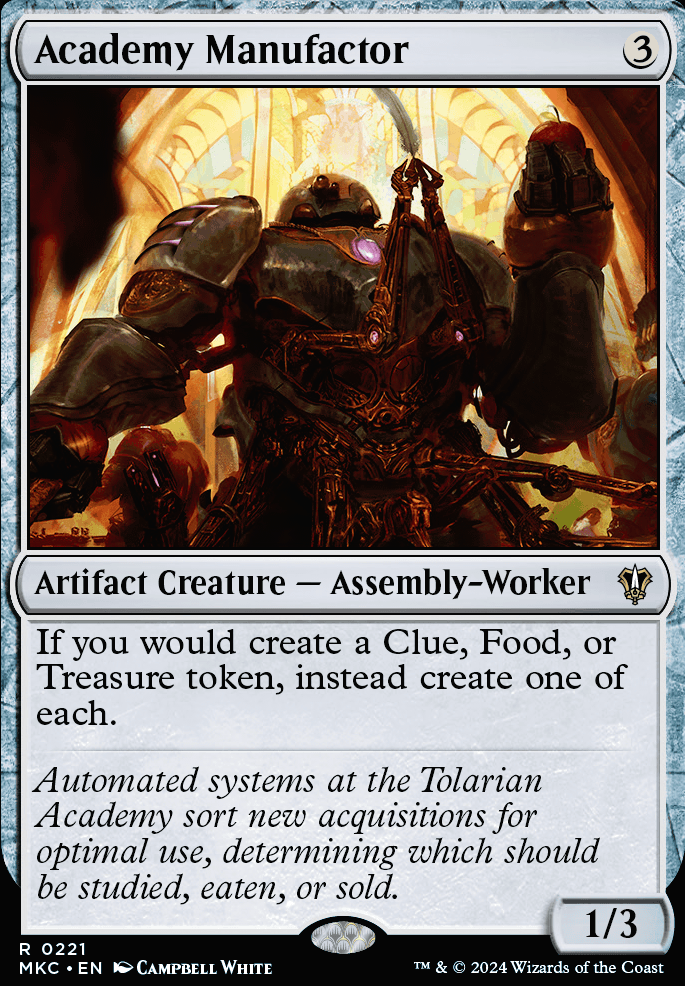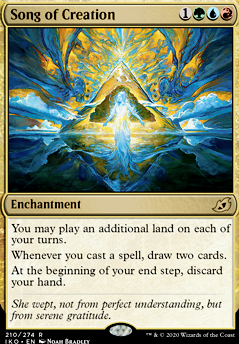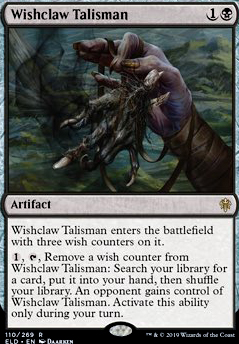If our deck has no duplicate cards, just play
Tainted Pact
in response to
Thassa's Oracle
to win the game!
Later on, I'll show through statistics and charts that
- This build has an 86% chance of winning by turn 5 and 64% chance of winning by turn 4
- Why you should probably play 2-3 copies of Pact rather than
Lutri
- Pros and cons of 2 vs. 3 copies of Pact
- Pros and cons of 1 vs. 2 copies of Oracle
Also check out the 4-color decklist
Basic Idea
If our deck has no duplicate cards, playing (1.)
Tainted Pact
just lets us exile our entire library. Then casting (2.)
Thassa's Oracle
just wins the game. At 4 mana and 2 cards, this is a highly efficient combo that can't be disrupted by removal.
(Note: If opponent has a counterspell, then they can just counter
Oracle
and we lose. To mitigate this, we should cast
Oracle
first and let it resolve before casting
Pact
in response to the trigger. This means opponent is forced to either counter the Oracle with our deck intact, or counter Pact. We lose our combo pieces, but still have a chance to win the game.)
Isn't it inconsistent to play combo with only 1 of each card?
Quite the opposite! With 3 ways to tutor Pact (
Grim Tutor
,
Solve the Equation
, and
Wishclaw Talisman
), that means we have access to 6 copies of combo piece (1.) (the
Pact
).
Combo piece (2.) doesn't actually have to be
Oracle
.
Jace, Wielder of Mysteries
also works. More interestingly, if we have a second
Pact
, that one can be cast to find the Oracle. A copying (e.g.
Dual Strike
) or
Regrowth
-type spell also counts as a second Pact since we can use the first Pact twice. And of course directly tutoring the Oracle also works. That gives us 1 (Oracle) + 1 (Jace) + 2 (extra copies of Pact) + 6 (copying spells) + 2 (Regrowth-type spells) + 3 (tutors) = 15 copies of combo piece (2.).
There are actually many more tutor and copy spells we could play, but I cut them because it's too many! 6 and 15 copies of our combo pieces is more than most combo decks and already gives us 91% chance of achieving combo by turn 4. 86% chance if we also consider needing 4 lands.
Why do we have 3
Pact
s if our deck can't have duplicates?
Not a problem - when we cast
Pact
1 and exile Pact 2, just take Pact 2 and recast it. Now the rest of our deck has no duplicates. So really we can play up to 4 Pacts if we want. But since it costs 2 extra mana to stop and cast each Pact, I believe the sweet spot is 3 Pacts to maximize consistency while still achieving a turn 4 win (fastest possible without mana acceleration or having exactly Pact + Oracle).
Detailed Analysis
Should we play 2-4
Pact
s or 1
Pact
+ Lutri?
I've seen people try to play Lutri so that we're guaranteed a copier for Pact, so Pact alone wins the game. This is probably incorrect. First of all, comboing with Lutri wins on turn 6 because you need 5 mana to play Pact + Lutri and then have to wait another turn to cast Oracle. In addition to spending 3 mana on turn 3/4, it seems unlikely a deck that does nothing on turns 3 and 5 in order to win turn 6 is competitive.
Second, as discussed in the Basic Idea section, we already have an overabundance of ways to find combo piece (2.) (15 in our build, but you can play 25+ if you want to include overpriced pieces like Lutri). The chokepoint is getting the first copy of Pact, not the second combo piece.
Let's rigorously compare the two:
A. Without Lutri means finding one out of 6 copies of (1.) and one of 15 copies of (2.)
B. With Lutri means finding one out of 5 copies of (1.) and guaranteed copy of (2.) (I'm being generous by adding
Mastermind's Acquisition
to the Lutri build, even though we cut it from our build due to overprice.)
A multivariate hypergeometric calculation shows that the chance of assembling combo with deck A is 86% chance on turn 4/5. Deck B is 82% chance on turn 6. (Calculations include needing 4 and 5 lands respectively). So not only is deck A more consistent, it can execute the combo on turn 4-5 whereas deck B typically assembles on turn 6.
Note that this significantly downplays deck A because naturally we have an even better chance of assembling by turn 6 (with 2 more turns to draw cards) and we're also only playing combo pieces that can win by turn 4-5. If compared fairly (by assuming both are trying to combo on turn 6), it's deck A 98% vs. deck B 82%.
That said, the Lutri build can cut corners on copies of combo piece (2.), letting it play a more controlling game, so it's not clearly strictly worse than this build.
Does playing 3
Pact
s slow down our win compared to 1 or 2?
No it's (almost always) the same speed. And I'll show later that 3 Pacts might even be slightly faster on average. In the table below, for each combination of cards in hand and # of Pacts in deck, I showed the turn it wins (without acceleration):
| # | Pacts | in | Deck |
|---|
| In Hand | 1 | 2 | 3 | 4 |
| Pact + Oracle | 3 | 3 | 4 | 4 |
| Pact + 3 mana tutor | 4 | 4 | 4 | 5 |
| Pact + copier | 5 | 5 | 5 | 6 |
| 3 mana tutor + copier | 5 | 5 | 5 | 6 |
So you can see that the only time 3 Pacts is faster is the dream hand of Pact + Oracle. In every other case, there's no difference. 4 Pacts on the other hand makes the deck much slower. (I don't have room to show the work at arriving at each number, but it shouldn't be too hard to see. For example, with a copier, every combination will be at least T5 since you can't even play Pact + copier until T4.)
Naturally 2 Pacts has a chance of being faster with turn 3 nut draw. However, 3 Pacts increases the chance you'll assemble the combo and win on turn 4 and 5, so which is better on average? See the table below which shows chance of winning by a given turn:
| # | Pacts | in | Deck |
|---|
| Winning by Turn | 1 | 2 | 3 | 4 |
| T3 | Strictly worse | 17% | 0% | 0% |
| T4 | Strictly worse | 39% | 46% | 34% |
| T5 | Strictly worse | 84% | 88% | 59% |
| T6 | Strictly worse | 88% | 92% | 94% |
| T7 | Strictly worse | 92% | 96% | 96% |
| Average Turn | Strictly worse | 4.80 | 4.79 | 5.16 |
So it appears the increased chance of assembling the combo with 3 Pacts slightly outweighs the increased chance of turn 3 nut draw. Overall, 3 Pacts will win on turn 4.79 average while 2 Pacts wins turn 4.80 average. However, if turn 3 win is worth significantly more than assembling the combo overall or winning earlier on average, then 2 Pacts is better. 4 Pacts appears to be just worse in all respects.
Should we play 1 or 2
Oracle
s?
As discussed in the Basic Idea section, we already have an overabundance of ways to find combo piece (2.), so another Oracle doesn't greatly improve our chances of winning with the combo.
Meanwhile it does come with two downsides:
- It shuts off our win with
Pact
+
Jace
since we'll hit two Oracles
- It increases the chance of fizzle if we try to gamble by playing an early
Pact
to speed up the win by removing Pacts from our deck. If we hit an Oracle, we can no longer win by copying Pact.
That said, we can still win with Jace despite 2 Oracles in deck (just requires some luck), so it could be correct.
Why not just cut
Jace
and play 2
Oracle
s? We can even play Lurrus!
Jace means we have a backup plan and don't automatically lose to Hushbringer, Necromentia, Meddling Mage, etc. (although if they name Tainted Pact, we still probably lose). Whether it's worth occasionally paying 2 extra for Jace is debatable though.
However, 2 Oracle + Lurrus has its advantages.
Gameplay
When mulliganing, just try to find a copy of combo piece (1.): a
Tainted Pact
or tutor. The other combo piece is easy to find so no need to mull for it.
Play card selection spells to dig for combo, and board wipes to stall for time.








